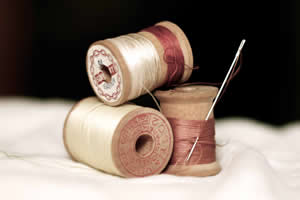Lifeline exists for textile crisis
Is the decline of the textile sector in Romania inevitable or has the industry talked itself into self-destruction? Asks Corina Ilie
 |
|
|||||||||||||
Romania’s textile industry is in decline, but a lack of Government incentives and a failure by the sector to recognise the competitive nature of the market must take a share of the blame.
Since Communism the country has been a target for lohn production, with workers stitching together materials in a kit using raw materials from Asia and designs from parent companies based in countries such as Italy and the UK.
There are also a group of succesful domestic firms, such as Pasmatex and J&R Enterprises, although all local companies are now feeling the pressure of an appreciating currency, larger salary expectations and high taxes on employees.
The decline of the textile market in eastern Europe began in 2000, when importers began to focus on China, Bangladesh, India and Morroco for mass produced items. Now experts agree the industry must reform in reaction to the market and move beyond lohn production.
But the industry is not in a crisis yet. Romania remains the most competitive textile producer in the European Union. The total value of the production in 2007 was of 6.36 billion Euro, of which products worth 5.4 billion Euro were exported. Official forecasts also point to an ascending trend by 2010.
There also remains a demand for complex and luxury products in lower quantities that require high standard technology. Due to Romania’s proximity to the west, its producers can also ensure shorter delivery times to market than Asia - of days as opposed to weeks. “Importers are willing to pay higher prices for these products,” says Rita Ferencz, director of local luxury fashion brand Rozalb de Mura.
Talent lack
Great textile and tailoring nations such as UK, France and Italy have managed to retain their status as clothing capitals due to investment in design schools and a broad-based encouragement of talent from state and private players. This has compensated for these nations’ decline in high-intensive manufacture.
But Romania has no fashion schools of merit and design is a key element which does not gain any Governmental support.
“It is unbelieveble that in an area where creativity is an important advantage, state agencies do not support design contests or workshops that stimulate art students, designers, producers and customers at the same time,” adds Ferencz.
Many textile companies do not have specialised designers to draw up their collections. The irony is that for a country which depends so much on the textile industry, it holds the status of the designer in such low esteem.
“Manufacturers avoid hiring designers, because they believe they will have to pay them high salaries,” says Romanian textile designer Kinga Varga. “The factory owners’ wives usually draw up the collections and then the sales are low, but still they refuse to hire specialists. Instead of working for the domestic market and providing not just products, but design also, they prefer to work in lohn and pay fewer salaries.”
A lack of courage to establish a domestic brand not focused on lohn is also holding back the industry. “Producers have little branding, sales or export knowledge,” says Ferencz. Many companies go bankrupt because they do not have a good marketing strategy. “Specialists in the area have been saying for three years that lohn will disappear, but few companies have made efforts to strenghten their brand on the domestic market,” says Varga.
New investment has been targeted to garment and wool products, while raw materials such as wool have been neglected. Natural, artificial and synthetic silk for clothes, linen and cotton for furniture uplholstery and beds, as well as wool, are the only materials still produced in Romania.
All post-communist Governments have neglected to establish development policies for small and medium enterprises (SMEs) in the textile industry. Without incentives for investment or tax exemptions for key industries, the Romanian textile industry has not kept pace with modernisations on the global market.
“The Government should implement co-financing programmes for SMEs, so these enterprises can access structural funds,” says Maria Grapini, president of Federatia Patronala a Industriei Usoare (FEPAIUS) and general manager of textile company Pasmatex. “Investors in the natural material production, such as cotton, hemp and wool, should be exempt from a tax on reinvested profit.”
Until then, factories producing basic and simple items, such as trousers or dresses, and those specialised in small lines that require complex technologies, like lint jackets, are most likely to survive. “As long as the owners of such factories make investments in upgrading the technology and do not force their staff to work for an unlimited number of supplementary hours, they still have a chance,” says Ferencz.
Migration season
The key problem for mass produced items is a lack of workers willing to spend eight hours a day in a high-intensive factory job. Workers in textiles have more than halved from 880,000 in 1990 to 400,000 in 2007. These employees now earn an average salary of 268 Euro per month for a 40 hour week. “The salaries are so low because employees are not competitive, the productivity is low and a Romanian employer has to pay the highest taxes in Europe on salaries,” say Grapini.
Labourers also leave this industry because of the effort needed to work on sewing machines, the mundane daily routine and the lack of promotional prospects. “Producers permanently monitor workers’ productivity and quality levels and this becomes unbearable at some point for the employees,” says Ferencz.
Labourers prefer to work in hypermarkets, where the salaries are similar but the job is easier. Others find jobs in the car parts industry or in the service sector. “If the administrative staff left, there would be no problem,” says Joseph Seroussi, president of clothes producer J&R Enterprises. “But the sewers leave and they are irreplaceable.”
In the last two years J&R has lost 2,500 employees and closed down two factories in Calarasi and in Tulcea, because of the labour shortfall. In its remaining five factories the company has 6,000 employees, but this is not enough. “We work in one shift instead of two and this reduces the production quantity,” says Seroussi.
The businessman says he offers the highest salaries in the area, up to 350 Euro per month, but this is as far as he can go to be competitive. “The Far East and Africa have very cheap workforce and importers have many alternatives,” adds Seroussi. “The US or European importer can chose to buy products from the whole world, he is not forced to buy from me.”
Importing cheap workforce from other countries such as China, Bangladesh or India is not a cost effective alternative, argue factory bosses. Besides the salaries, the producer has to pay for accommodation and meals for workers, while securing legal work permits can take years.
“Where can I accommodate 2,500 people coming from other countries?” says Seroussi. “I have to bring translators to communicate with them and I must hire a chef to cook for them, because they do not eat the same type of food as us.”

















